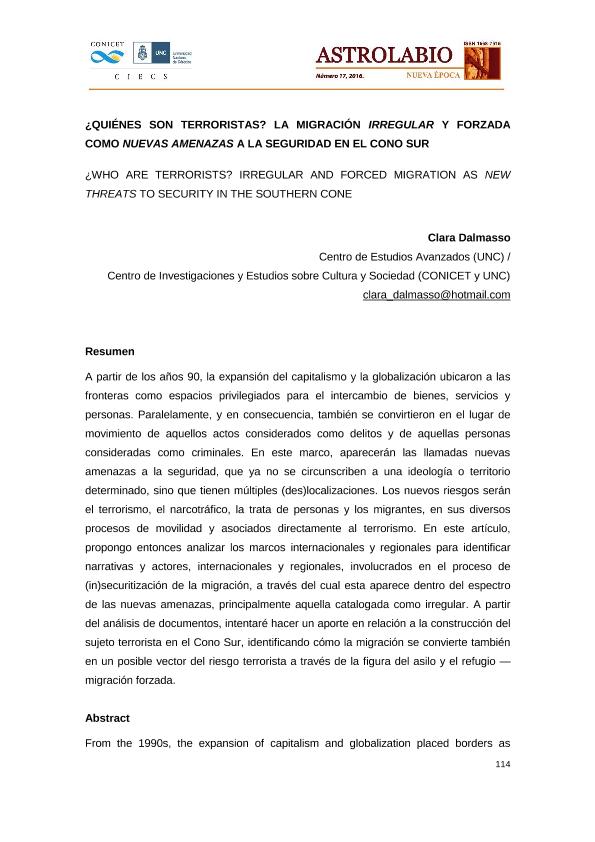Mostrar el registro sencillo del ítem
dc.contributor.author
Dalmasso, Clara

dc.date.available
2019-01-02T16:02:43Z
dc.date.issued
2016-12
dc.identifier.citation
Dalmasso, Clara; ¿Quiénes son terroristas? La migración irregular y forzada como nuevas amenazas a la seguridad en el cono sur; Centro de Investigaciones y Estudios sobre Cultura y Sociedad; Astrolabio; 17; 12-2016; 114-145
dc.identifier.issn
1668-7515
dc.identifier.uri
http://hdl.handle.net/11336/67193
dc.description.abstract
A partir de los años 90, la expansión del capitalismo y la globalización ubicaron a las fronteras como espacios privilegiados para el intercambio de bienes, servicios y personas. Paralelamente, y en consecuencia, también se convirtieron en el lugar de movimiento de aquellos actos considerados como delitos y de aquellas personas consideradas como criminales. En este marco, aparecerán las llamadas nuevas amenazas a la seguridad, que ya no se circunscriben a una ideología o territorio determinado, sino que tienen múltiples (des)localizaciones. Los nuevos riesgos serán el terrorismo, el narcotráfico, la trata de personas y los migrantes, en sus diversos procesos de movilidad y asociados directamente al terrorismo. En este artículo, propongo entonces analizar los marcos internacionales y regionales para identificar narrativas y actores, internacionales y regionales, involucrados en el proceso de (in)securitización de la migración, a través del cual esta aparece dentro del espectro de las nuevas amenazas, principalmente aquella catalogada como irregular. A partir del análisis de documentos, intentaré hacer un aporte en relación a la construcción del sujeto terrorista en el Cono Sur, identificando cómo la migración se convierte también en un posible vector del riesgo terrorista a través de la figura del asilo y el refugio ?migración forzada.
dc.description.abstract
From the 1990s, the expansion of capitalism and globalization placed borders as privileged spaces for the exchange of goods, services and people. In parallel and as a consequence, they became also the place of movement of those acts considered as crimes and of those people considered as criminals. In this context, the so-called new threats to security will appear. Those threats are no longer limited to a specific ideology or territory, but rather have multiple (dis)locations. Within these, the new risks will be terrorism, drug and human trafficking, and migrants, in their various mobility processes and also directly associated with terrorism. In this article, I propose to analyze the international and regional frameworks to identify international and regional narratives and actors involved in the process of (in)securitization of migration through which it appears within the spectrum of new threats, especially those classified as irregular. By document’s analysis, I will try to make an input to the field regarding the construction of the terrorist subject in the Southern Cone, identifying how migration also becomes a possible vector of terrorist risk through the figure of asylum and refuge (forced migration).
dc.format
application/pdf
dc.language.iso
spa
dc.publisher
Centro de Investigaciones y Estudios sobre Cultura y Sociedad
dc.rights
info:eu-repo/semantics/openAccess
dc.rights.uri
https://creativecommons.org/licenses/by-nc-sa/2.5/ar/
dc.subject
Terrorismo
dc.subject
Migración Forzada
dc.subject
Migración Irregular
dc.subject
Nuevas Amenazas
dc.subject.classification
Ciencia Política

dc.subject.classification
Ciencia Política

dc.subject.classification
CIENCIAS SOCIALES

dc.title
¿Quiénes son terroristas? La migración irregular y forzada como nuevas amenazas a la seguridad en el cono sur
dc.title
¿Who are terrorists? Irregular and forced migration as new threats to security in the southern cone
dc.type
info:eu-repo/semantics/article
dc.type
info:ar-repo/semantics/artículo
dc.type
info:eu-repo/semantics/publishedVersion
dc.date.updated
2018-11-05T19:17:13Z
dc.journal.number
17
dc.journal.pagination
114-145
dc.journal.pais
Argentina

dc.journal.ciudad
Córdoba
dc.description.fil
Fil: Dalmasso, Clara. Consejo Nacional de Investigaciones Científicas y Técnicas. Centro Científico Tecnológico Conicet - Córdoba. Centro de Investigaciones y Estudios sobre Cultura y Sociedad. Universidad Nacional de Córdoba. Centro de Investigaciones y Estudios sobre Cultura y Sociedad; Argentina
dc.journal.title
Astrolabio

dc.relation.alternativeid
info:eu-repo/semantics/altIdentifier/url/https://revistas.unc.edu.ar/index.php/astrolabio/article/view/15705
Archivos asociados
